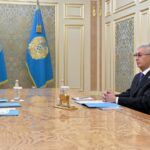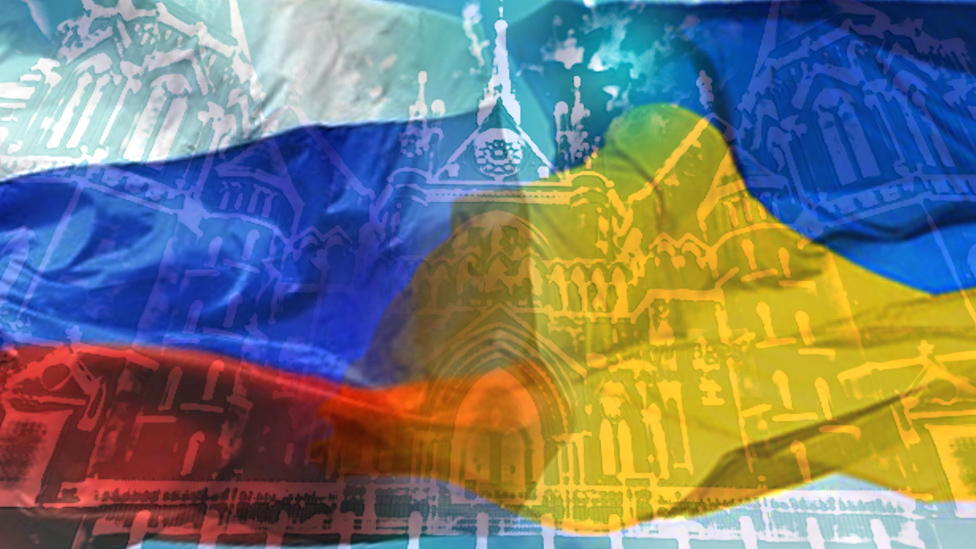Globalnews.kz hereby post the translation of Sultan Akimbekov’s view on the Russo-Ukrainian war. Mr. Akimbekov is a renowned Kazakh Orientalist, Historian, Sociologist and Political Observer, as well the Director of the Institute of Asian Research.
As of the beginning of 2024, the conflict between Russia and Ukraine has decisively entered a positional stalemate. While localized operations persist on the front lines, there is little progress in any sector. The Ukrainian offensive towards Tokmak became entangled in Russian defenses by autumn and essentially came to a halt. Although Ukrainians secured a foothold on the left bank of the Dnieper, maintaining it requires substantial effort and is accompanied by significant losses.
In turn, the Russian army’s attempt to seize the initiative and launch offensives on multiple fronts from Kupyansk to Avdeevka since the autumn of 2023 has yielded limited results. Despite capturing the small town of Marinka in the Donetsk region during intense battles, the outcome does not justify the considerable resources invested.
Against this backdrop, the warring parties increasingly fortify their positions, dig trenches, mine their positions, and, notably, assess available resources. In a war of attrition, where breakthroughs through dense defenses are no longer feasible, the availability of resources becomes a pivotal condition.
Overall, as of the beginning of 2024, Russia is in a more advantageous position in terms of available resources compared to Ukraine. Primarily, it has a significantly larger population that can be mobilized, and more opportunities to conduct conscription, even through the most stringent methods. It is clear that until March 17, 2024, the date of the presidential elections, Moscow is unlikely to initiate mobilization, as it did in the autumn of 2022. However, after the elections, it may mobilize as many forces as it deems necessary – ranging from half a million to a million.
Russia claims that there are 617,000 military personnel on the front lines; this figure was mentioned by President Vladimir Putin on December 14 of the previous year. Ukraine cites a lower number of Russian troops in the combat zone, ranging from a minimum of 400,000 to 500,000. Additionally, Russia can recruit additional individuals on a contractual basis each month, thereby compensating for current losses.
As of December 12, 2023, according to President Volodymyr Zelensky, the Ukrainian ground forces comprise 600,000 personnel. Earlier in September, Defense Minister Rustem Umerov stated that the Armed Forces of Ukraine (VSU) consist of 800,000 individuals, with an additional 200,000 in various other formations. Nevertheless, discussions in Ukraine actively revolve around the possibility of mobilization. In December, President Zelensky mentioned that the military had indicated the need for conscripting 500,000 individuals. On January 4, 2024, the Chief of the General Staff of the Armed Forces of Ukraine, Valeriy Zaluzhny, addressed the Verkhovna Rada, stating, «I need people… whom should I fight with?». In mid-January, a more stringent draft law proposed by the government will be considered.
However, the conscription process is increasingly challenging. On one hand, Ukrainian authorities in 2023 made a populist decision to dismiss all military commanders, some of whom had significantly enriched themselves during the war. However, the new personnel struggle to organize the conscription process, at least not as efficiently as before. In November of the previous year, deputies from the relevant committee of the Verkhovna Rada stated that mobilization had failed. Videos periodically surfacing with incidents on the streets of Ukrainian cities, where individuals avoiding conscription are apprehended, do not contribute to resolving the issue.
In Russia, sweeps for conscripts also occur, but for its authorities, it does not pose the same difficulties as it does for the democratic authorities of Ukraine. Moscow’s assertiveness in organizing the draft aligns with its overarching image of a strong and even ruthless government. In this regard, it faces no constraints. The only thing holding it back is the upcoming elections on March 17.
Yet in Ukraine, the authorities appear more vulnerable to public opinion, as is the case in any democratic state. Therefore, the necessary assertiveness in organizing wartime activities demands considerable effort from them and carries serious risks to their political reputation. This is precisely why the Chief of the General Staff of the Armed Forces of Ukraine, Zaluzhny, on January 4, essentially pressured the deputies of the Verkhovna Rada to adopt a more stringent law.
For all participants on both sides of the conflict, the complexity of the situation lies in the fact that if the front has already stalled, mobilization will not radically alter the situation. The number of people on the front undoubtedly matters, but for breaking through fortified defensive lines, defeating the enemy, and occupying large territories, it is no longer the key factor for success.
In this context, one may recall the Iran-Iraq War of 1980-1988 as the closest example of a severe confrontation between two neighboring countries. Iraq sought to take advantage of Iran’s weakened state after the 1979 revolution and capture the ethnically Arab-populated oil-producing province of Khuzestan. Following initial setbacks, Iran conducted mobilization, including rallying motivated youth inspired by the Islamic revolution, and reclaimed the occupied territories.
Iran employed «human wave» tactics, sending tens of thousands of volunteers and conscripts against fortified Iraqi positions. The conflict then became entrenched in positional warfare, evolving into a «war of cities,» with both sides shelling each other’s cities with missiles, artillery, and conducting air raids. Additionally, they targeted each other’s tankers in the Persian Gulf, attempting to disrupt oil trade.
Iraq received support from Arab states in the Persian Gulf, the U.S., France, and the U.K. Iran procured weapons from China, Pakistan, North Korea, and Libya, while the Soviet Union mainly supplied Iraq. Both sides attempted to use forces opposing the ruling regimes. Iraq supported Iranian Kurds, labeled separatists in Iran, and a left-radical Iranian organization called the «People’s Mojahedin.» In turn, Iran supported Iraqi Kurds, considered separatists in Iraq. In Tehran, attempts were made to leverage Iraqi Shiites, but Saddam Hussein’s harsh regime prevented them from gaining such an opportunity. Moreover, Saddam opposed Arab nationalism to religious solidarity with Persian Shiites. Ultimately, in 1988, the war ended inconclusively, with both sides maintaining their positions but suffering heavy losses.
In this historical context, it is essential to note that the warring parties were able to sustain a relatively long period of positional warfare, accompanied by a «war of cities» and a «tanker war.» Following this epic confrontation, there have been no examples of a similar war of attrition between opposing forces. All subsequent wars were relatively short when fought by regular armies and quite prolonged when involving guerrilla warfare.
Compared to the Iran-Iraq War, the ongoing conflict between Russia and Ukraine has introduced new trends in military affairs. It vividly illustrates that breakthroughs in pre-prepared layered defenses cannot be guaranteed by large infantry masses, a significant number of tanks, or even artillery. In the past six months, both Russian and Ukrainian forces have de facto slowly eroded the enemy’s defense with small infantry units. This is because any larger infantry formations with equipment would be detected many kilometers away from the front line and attacked either while marching or approaching the line of engagement. In the 1980s, the Iranians could concentrate 100-120,000 soldiers and 500 tanks against 20-30,000 Iraqi soldiers relatively unnoticed on a specific front. However, even in the case of breakthroughs by the Iranian army, the Iraqis managed to establish new defensive lines in the immediate rear.
In this current war, upon the discovery of large enemy formations or troop concentrations on one front, the adversary can swiftly shift reserves of artillery and multiple launch rocket systems to the threatened direction, concentrate them, inflict heavy losses, and thwart attempts at advancement. Incidentally, this is likely why Russian forces have been attacking on multiple fronts in the last two months—from Kupyansk through Avdeevka to the left bank of the Dnieper.
If you have half a million soldiers and a couple of thousand tanks on the front, but cannot concentrate them for an assault akin to those of the first or second world wars, it becomes logical to attack on all possible fronts with relatively small groups. This keeps the Ukrainians under constant pressure, especially given their limited artillery and ammunition supplies, and allows for local successes by forcing them out of their positions.
However, there are challenges in implementing such tactics. The enemy has enough time to establish a new line of fortifications in the immediate rear. When the Ukrainians conducted their offensive last summer, they faced similar difficulties. Although they reached the main defensive line near Verbne and Rabitne, it took them a considerable amount of time—more than enough for the Russian army to create new defensive structures.
The shift towards positional warfare is primarily driven by the fact that both sides no longer have the capability for offensives, and mobilization, at this point, will not be of significant help unless the war extends for an additional five or six years. However, it is crucial to reiterate that Ukrainians are more sensitive to large losses than Russians, and they have a smaller overall population. Clearly, it will be challenging to justify to the public a strategy for further actions. Achieving a return to the borders of 1991, which was stated as the goal of this war in Ukraine, seems difficult now. This would be challenging not only with current forces but even with additional mobilization. Obtaining weapons poses obvious difficulties.
From the perspective of weapons availability, Russia currently holds a more advantageous position. According to somewhat imprecise data, Russia can independently produce up to 2 million shells annually, allowing for the expenditure of approximately 5,500 shells per day. Of course, this is incomparable to the 50-60 thousand shells that, again according to unverified data, Russian forces purportedly produced daily during the operation near Bahmut last winter. Even if the numbers were lower then, by now, the stockpiles of shells have been depleted, and Russia is using them on a much smaller scale.
Nevertheless, Russia’s own production of shells is a significant advantage. Additionally, there’s some quantity imported from North Korea. In any case, the Russian army has enough shells to conduct positional warfare. It may not be sufficient for organizing artillery offensives like those in the Second World War or even the one near Bahmut last winter, but it is adequate for a protracted war of attrition.
The exact number of shells Ukraine can produce today is unknown. According to, again, unverified data, it allegedly fires only 2,000 shells per day, compared to around 7,000 in the summer. The actual number of shells Ukraine has daily is unknown, but it is undoubtedly less than in the summer. It is crucial in this context that the Ukrainian army critically depends on external supplies.
However, Europe and the USA have yet to establish production capacities sufficient to meet all of Ukraine’s ammunition needs. For instance, Europe failed to fulfill its declared plan last year to supply Ukraine with one million 155mm shells. The latest military aid shipment from Germany in early 2024 included only 10,000 shells of 155mm caliber. This would only suffice for a few days of intense combat.
At the beginning of December 2023, «The Washington Post» claimed that indirect deliveries of ammunition from South Korea to Ukraine in the summer of the same year exceeded those from Europe. Seoul immediately denied information about supplying lethal weapons to Ukraine. Nevertheless, various reports indicated that South Korea had provided the United States with around 300,000 155mm caliber shells, enabling them to supply their ammunition to the Ukrainian army. In any case, the shortage of ammunition remains a critical issue.
The question of insufficient shell supplies is pressing. Industrial capacities in Europe and the USA do not allow for rapidly increasing their deliveries, requiring time to set up production. While Russia will also reach the limit of its existing technological capacities, expanding them would demand new investments, which are challenging under sanctions. However, Russia already has these capacities, while Europe and the USA need time to establish production.
In early 2023, the USA produced 14,000 155mm caliber shells per month, which increased to 28,000 in the fall, with plans to reach 100,000 by 2025. However, it’s evident that Ukraine cannot rely on all these volumes. For example, consider the situation with the supply of only 50 American «Abrams» tanks to Ukraine, despite the USA having several thousand in stock. Additionally, the conflict around the Gaza sector, which teeters on the brink of escalating into a regional conflict, may require American shells for Israel.
Undoubtedly, Americans and Europeans will continue supplying weapons and ammunition to Ukrainians, as they cannot afford their defeat. However, it is unlikely that this will be enough for a full-scale offensive. This is partly because the war has reached a positional stalemate. In this situation, both sides have sufficient forces and resources to hold their current positions, but clearly not enough to attempt a decisive victory.
If the front has halted, then the urban warfare is just beginning. On December 29, just before New Year’s Eve, Russia launched the most powerful missile and drone strike on Ukraine during the entire war. While most of them were intercepted, the damage was significant. Observers claimed it was a response to the Ukrainian strike on the port of Feodosia on the night of December 26, where a large landing ship, the «Novocherkassk,» was sunk. On December 30, Ukrainian forces struck Belgorod, marking the most powerful attack on a Russian city since the beginning of the war.
In this case, it matters that in the conditions of the actual freezing on the front line, the use of missiles, strike drones, as well as MLRS and artillery in border areas is intensified. Russia has an advantage here due to the large quantity and variety of missile weaponry it produces independently. There are many opinions about the scale of missile production; however, Russians have clearly overcome the crisis in their production associated with the imposition of sanctions. Moreover, there are rumors that Russia allegedly buys missiles from North Korea and Iran. On the night of January 8, Russia delivered a new strike, using more than 50 missiles, of which Ukrainians reportedly managed to shoot down only 18.
In the situation of Russian superiority in missile weapons, the key for Ukraine is the supply of anti-aircraft missile systems and missiles for them. They are effective, but there are few of them, and they are very expensive. Therefore, Russia can overload Ukraine’s air defense system and force them to spend scarce missiles. Western countries face limitations in stocks of missiles for air defense and difficulties in their production. For example, a missile from the «Patriot» system, which can intercept ballistic missiles, costs between 2 to 4 million dollars. In December, it was announced that Europe would pay 5.5 billion dollars for the production of 1,000 new missiles of this kind.
This is also part of the war of attrition — who will win, the hypothetical shield or the hypothetical sword? Does Russia have enough missiles, whether its own, North Korean, or Iranian, to strike Ukrainian cities for an extended period, or will Ukraine have enough air defense missiles to repel these attacks? Currently, it seems that in the last few months of 2023, Russia has accumulated a certain reserve of missiles to demonstrate Ukraine’s vulnerability and weaken its readiness for resistance. However, it is unknown how long this reserve will last and what the production capacity for these missiles is.
At the moment, the current balance of forces appears to be more favorable for Russia. In December 2023, ‘The Wall Street Journal’ named Russian President Vladimir Putin the geopolitical winner of the year. This can be interpreted in different ways and does not necessarily sound like a compliment, but Moscow feels much more confident than it did in the summer of the previous year. Therefore, in December 2023, President Putin stated that he was ready for negotiations with Ukraine, Europe, and the USA. At the Defense Ministry’s meeting on December 19, he said, ‘We won’t give up what’s ours. If they want to negotiate, let them negotiate. But we will do it based on our interests.’ Clearly, this is a display of confidence before the domestic audience, but at the same time, it is a claim to very tough negotiating positions, which Russia does not hide.
However, the ‘war of cities’ can be a double-edged weapon. For instance, Ukraine has already bombed Belgorod. Previously, they targeted mainly military objects in Crimea and some other Russian regions. But Belgorod is a different story. Thus, Ukrainians have essentially indicated that theoretically, they could also resort to city attacks.
If Kharkiv is vulnerable, then Belgorod is also vulnerable. Moreover, Kyiv claims that this year they will produce many drones, some of which resemble Iranian ‘Shahed.’ Accordingly, at some point, they might use them, and these are very imprecise weapons. Certainly, Russia has highly effective electronic warfare (EW) means, as many observers note. The use of these means is associated with a recent decrease in the activity of Ukrainian drones. However, the question is whether they can handle the mass use of drones if it suddenly begins.
On medium and long distances, for example, in the territories occupied by Russia, Ukraine mainly uses American Himars, ATACMS, and British Storm Shadow missiles. This allows Ukraine to disrupt logistics and communication, as well as destroy command centers and supply centers behind the Russian army. However, there are not many of such missiles, and there are still some limitations on their use over Russian territory. Therefore, it is noted that the strike on Belgorod seemingly involved «Olha» missiles, which are Ukrainian equivalents of the Russian long-range MLRS «Smerch.» It is noteworthy that this information is being discussed in Russia. This may be related to the fact that Russian authorities are very sensitive to public opinion when hypothetical American missiles attack objects on Russian territory.
In a sense, this war remains somewhat unspoken or not entirely clearly defined in terms of its objectives, at least from the Russian side. Nearly two years of confrontation, and Russian gas continues to flow through Ukraine, with Moscow paying Kiev for transit. The northern border remains closed, but there is one crossing point, and diversionary groups from both sides periodically cross it. Rumors are circulating that Russia allegedly plans to open the northern front and advance towards Kharkiv again in mid-January.
However, this would mean expanding the front line, whereas there are no active hostilities by default on the northern border. Both sides somehow agreed not to engage in fighting at the border after Russian forces withdrew from northern Ukraine in the spring of 2022. Obviously, it is much more challenging to conduct positional warfare not over 1300 kilometers, as it is now, but over, let’s say, 2000 kilometers. New troops, new resources would be required, and the war would directly impact the former territory of the Russian Federation.
It is crucial to note that for Russian public opinion, the question of the old lands of the Russian Federation is very important. Despite the official annexation of four new entities based on Ukrainian regions, they are perceived differently than the main territory of Russia. At the same time, it is important for the authorities that society does not feel like the war is happening close by. For Moscow, it is essential that everything looks normal overall. Therefore, it is unlikely that Russia will open a new front in the north. Perhaps Russian forces are wary of any actions from Ukraine, such as intensifying shelling in cities like Kharkiv and Sumy.
One can assume that the observed redeployment of new units to the Belgorod region in January is precisely a preventive measure in the context of transitioning to positional warfare. In such a case, the adversary seeks weak points in the defense line where damage can be inflicted. In the Iran-Iraq war, when the front line stabilized in the south around Basra, Iran and Iraq at different times attempted to use peripheral regions, where Kurds lived, for offensives.
In particular, in 1987, with the support of Iranian forces, 30,000 Kurds attacked the Iraqi army, prompting Iraq to redeploy up to 10 additional divisions to the north. In June 1988, Iraq supported 20,000 fighters from the Iranian organization «People’s Mojahedin,» who invaded Iran. On the same day as the first ceasefire negotiations on July 26, Iranian opposition attacked Iran and advanced up to 100 km into its territory. Baghdad did not support them, and Iranian forces quickly defeated them.
This example is important in the context of discerning the intentions of conflicting parties. Most likely, they will not use certain opportunities but must consider their probability. At least to divert the adversary’s forces from the most crucial sectors of the main front. This suggests that the parties are preparing for a prolonged continuation of this war. Paradoxically, however, this implies that what is happening is approaching, if not a truce, then a freezing of the conflict. Because a war of attrition is a struggle for resources.
This means that the decisive role in this conflict has now become squarely the domain of the West. Essentially, only Western countries can make a decision that will impact the outcome of the confrontation. This is because only they have the resources to change the course of the conflict. If Russia shifts to positional warfare, it is, in essence, agreeing to it. It is betting that it can endure a positional war until the point where the US and the EU tire of supporting Ukraine. Then they would be forced to make a deal. However, if the support continues, even under the hypothetical presidency of Donald Trump, then this bet will not play out. Therefore, everything now depends on the decisions of the US and the EU.
Certainly, this doesn’t entirely align with Ukraine’s expectations. In Kyiv, they anticipate that the West should provide the level of resources necessary to achieve the goal of reaching the borders of 1991. However, it is now clear that Western countries will not do this. It would be too costly and does not guarantee results; overcoming Russian defense would be very difficult. Therefore, they will supply just enough to hold the front line, conduct local operations, and prevent Russia from winning the «war of cities.» For this, air defense systems and possibly a few dozen F-16 fighters are needed. Even if Donald Trump comes to power, this policy will likely continue.
From Ukraine’s perspective, they would prefer to avoid such a minimalist scenario with Western support. A war of attrition is generally not advantageous for them. Therefore, Kyiv is trying to convince the West that more military aid is needed, and it is necessary to ultimately win this war. However, in the West over the past two years, it has become clear that conducting offensive wars in the classic sense of World War II or even the Iran-Iraq war is becoming quite challenging today. This holds true for both the Ukrainian and Russian armies. Therefore, it is unlikely that one can expect another war from Russia against one of the European countries in the medium term, as is often discussed in Ukraine.
Essentially, a war of attrition is, in fact, coercion towards a ceasefire. Especially since Russia cannot shift to a mobilization economy with its planning reminiscent of the USSR. Without this, there is no point in talking about a new Cold War. Moscow simply has no means to acquire equipment for establishing new production. For example, before World War II, the USSR managed to purchase equipment from the United States. But even if it somehow succeeds now, it will only lead to an increase in the production of previous models of weapons, the same shells or mines. In contrast, modern warfare primarily involves technology and satellites. But if we are not talking about a Cold War with its ideological confrontation, then there is room for realpolitik.
It is worth noting that in the centuries-long history of relations between Russia and Europe, there have been various complex moments. They have always been characterized by their organization but could not do without each other. At the same time, Europe has always realized that changing Russia is impossible. After any upheavals, it always returns to the format of centralized bureaucratic statehood. In recent history, this happened after 1917 and after 1991. But similarly, after each harsh period in Russia, there is a relaxation of pressure on society, reforms are initiated to strengthen the military-political component, and there is a search for ties with Europe for technologies and many other circumstances.
Therefore, the transition to positional warfare in Ukraine, associated with a war of attrition, essentially appears as the conclusion of another cycle, after which a new stage will begin after some time. What it will be exactly, we do not know, but it will likely resemble all the previous ones. After Ivan the Terrible, there was Boris Godunov with a more lenient policy and the engagement of foreign specialists; after Peter I, various empresses, especially Catherine II, with her correspondence with Voltaire; after Nicholas I, Alexander II, and the era of great reforms began; after Lenin, there was the New Economic Policy (NEP); after Stalin, Khrushchev; after the Kremlin elders, Gorbachev. Although all of this is highly conditional, the trend is quite evident.
This can be added to the military aspect. After the defeat in the Livonian War, Godunov attracted Western specialists. After the Time of Troubles, the first Romanovs created regiments of a new type following the European model. After the unsuccessful Crimean War, among other moments, the Russian army underwent reforms. After the Russo-Japanese War, there were again military reforms. After the revolution and the Civil War, the Bolsheviks carried out military construction using Western technologies, including German ones in the 1920s. After the defeats of the early years in the Great Patriotic War, there was active use of Anglo-American military-technological developments. Russia has always been oriented towards Europe, although this interaction has not always been successful for both sides.
Of course, one can argue about how successful the course of this war looks for modern Russia. There can be many opinions, from defeat to victory. Nevertheless, it is clearly not a victory, even with territorial gains. But it is also not a defeat. In some ways, this resembles the Livonian War of the 16th century. First, a conditional blitzkrieg in the Baltic States, then the involvement of Poland and Sweden, a protracted war of attrition, actual exhaustion, the loss of many conquered territories, and some of its own, such as Ivangorod, located across from Narva. But overall, the result is relatively inconclusive, leading to a new cycle of centralized statehood.
In general, Ukraine finds itself in a difficult position because it means that it will be the one conducting the war of attrition. The West will support, but not to the extent of organizing a turning point, which is unlikely in military terms anyway. Perhaps Ukraine will have to endure several more years of exhausting warfare, including the «war of cities.» In the Iran-Iraq War, they eventually stopped shelling each other because they simply ran out of missiles. In the current war, this is unlikely to happen, given Russia’s domestic production capabilities and support from Iran and North Korea.
More importantly, the West itself is in a rather complex situation, both in the internal politics of various countries, the economy, and international relations. In this situation, supporting Ukraine becomes increasingly burdensome. On January 8, German Chancellor Olaf Scholz called on EU allies to intensify their efforts to support Ukraine. In Moscow, this was immediately interpreted as a sign of his irritation with the high cost Germany is paying in this war. In any case, assisting Ukraine requires significant funds, not only for the military but also for the economy.
The situation on the fronts also matters. A protracted positional war with a high degree of intensity in the center of Europe for many years does not align with the interests of Western countries. Obviously, as a result of this war and the imposition of sanctions, Russia has significantly weakened, but it is far from the critical condition that many expected.
Although statements by Russian representatives about Russia overcoming sanctions and demonstrating economic growth appear overly optimistic. This is mainly due to the growth of state spending in the defense industry, which, in turn, leads to high inflation. Nevertheless, the Russian economy clearly has a solid margin of resilience, even in terms of inflation. For example, in Turkey in 2022, inflation reached 80%, and in Argentina, it is currently 100%.
Certainly, Russia will try to avoid such undesirable developments. However, they could devalue the ruble by another 20-30% and ensure the fulfillment of the stated plans for budget revenue growth this year. The weak point for Russia today is the trends developing in the global oil market.
In the global economy, due to its slowdown, the demand for oil is decreasing, so the price may start to decline. Moreover, Venezuela is re-entering the market, Angola has left OPEC, and Saudi Arabia offers a $1.5 premium per barrel for the Asian market. In general, expectations are not the best. However, all of this will not manifest immediately. Russia has a few years during which it can maintain a relatively stable and unchanged state. But beyond that, decisions will have to be made about which direction to move in.
In any case, those who expected that economic difficulties would force Russia to at least retreat or become more compliant regarding Ukraine have been proven wrong. Similarly, those who believed that a repeat of 1991 and a new stage of liberal reforms were possible have also been proven wrong. So, the situation is gradually reaching an impasse, not only on the fronts but also in the entire confrontation between Russia and the West.
It is clear that no one is going to abandon their declared goals, but it is also evident that everyone needs a pause. Importantly, this is not about a ceasefire. That is impossible, given the different goals, and no one wants to back down from them. However, everyone would likely agree to a freeze, following the Korean War scenario of the 1950s. That is, without formal agreements, with possible excesses, but with the conclusion of the active phase of hostilities when, by default, no one is advancing.
The problem here is that the configuration of the confrontation line, where a freeze might occur, is too disadvantageous. More precisely, it is more advantageous for Russia. Because it allows them to hold on to the Dnieper. As a result, it maintains a land corridor to Crimea and can declare it as their victory. Moreover, theoretically, it may threaten the future southern coast of Ukraine. In this case, the Kinburn Spit will remain behind it.
For Ukraine, this is, of course, unfavorable, not only because it marks the loss of territories but also because it leads to a noticeable reduction in economic activity in the southern part of the country. If the Dnieper becomes the demarcation line, it becomes challenging to organize the economy of the extensive region where it flows. Consequently, Russia achieves its goals by paralyzing the remaining part of the Ukrainian economy east of the Dnieper or, at the very least, complicating its functioning.
Freezing the conflict according to the Korean scenario will inevitably cause disappointment in Ukrainian society. Because there were inflated expectations in Ukraine regarding the outcome of the war. It will be difficult for society to accept such a result. This will lead to dissatisfaction and an activation of internal politics. Against this background, elections will have to be held with unknown outcomes. However, this is part of the democratic process. The freeze will create a new political reality influenced by expectations regarding a hypothetical «Marshall Plan» for Ukraine. Nevertheless, the main result of this war is that in any future configuration of relations in Eastern Europe, Ukraine is de facto lost to Russia.
In a historical context, this struggle has continued since at least the beginning of the 16th century. Initially, it occurred between the centralized state in Moscow and the decentralized territories of the former Kievan Rus, initially under the Grand Duchy of Lithuania and later Poland. At that time, Moscow Grand Prince Vasily III besieged Smolensk three times, defended primarily by the local Orthodox Russian-speaking population under the command of Yuri Glebovich and Yuri Sologub. He managed to take the city by promising the citizens to preserve their privileges and rights, which they had in the Lithuanian state. A hundred years later, Polish King Sigismund, after a two-year siege, took the city and granted the population of Smolensk the Magdeburg city rights, the basis of Western European municipal self-government. It was also in Kiev, Minsk, Chernihiv, and many other cities.
It was a centuries-long war for the legacy of Kievan Rus and its population, determining who they would ultimately be, in which system of coordinates they would find themselves. Since the 17th century, Russia had an undeniable military advantage in this struggle due to its centralized statehood and the ability to concentrate efforts. But the situation is changing. It seems that we are now, in a sense, witnessing the final chords of this longstanding confrontation. It concludes with the definitive division of territory and population not only into different states and nations but into different politico-economic systems. Another matter is whether this is permanent or can still change, but probably not now.









